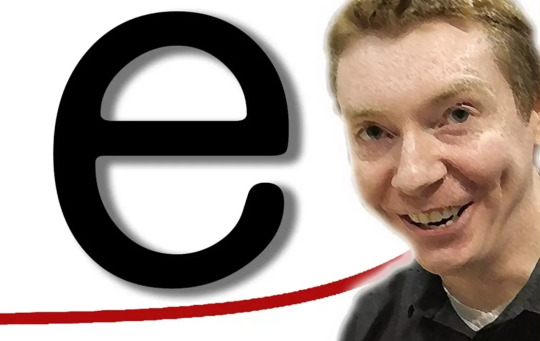#euler's number
Text
642 notes
·
View notes
Text
Number Tournament: THE AVOGADRO CONSTANT vs EULER'S NUMBER

[link to all polls]
the Avogadro constant
seed: 27 (20 nominations)
previous opponent: fourteen
class: SI defining unit
definition: the number of moles in a mole of moles
e (Euler's number)
seed: 6 (54 nominations)
previous opponent: gross
class: irrational number
definition:

#number tournament#polls#math#mathblr#avogadro constant#e#euler's number#wow NAvse looks like it could be an actual word#navse#jan misali
1K notes
·
View notes
Text

AIN'T no way e^i(π) is his cuddle buddy

#love the newest episode#it made me feel ill /pos#alan becker#avm#ava#animation vs math#ava tsc#ava the second coming#ava orange#avm tsc#avm the second coming#avm orange#ava yellow#avm yellow#ava red#avm red#does the.#does euler's number have a tag#euler's number#e^i(pi)#?? good enough#my art#ibis paint
651 notes
·
View notes
Text



You’re BEING IRRATIONAL
why does Pi sound identical to Beetlejuice also, I can’t be the only one who hears this right?
#none of these are finished I can’t come up with good outfits </3#art#bfdi fanart#bfdi pi#pi bfdi#pi xfohv#pie vs pi#how do people tag the other three#do I literally just go#euler's number#tau#square root of two#?? I don’t know
11 notes
·
View notes
Text

this beautiful equation contains the six most important constants in mathematics
#from left to right:#euler’s number#the funni seggs constant#the imaginary unit#half the ratio of a circle’s circumfrence to its radius#the multiplicative identity#and the additive identity#mathblr#mathcore#math#euler’s identity#e to the i pi
2K notes
·
View notes
Note
How many holes does a straw have?
@i-send-you-random-asks
(asking you specifically cause i think you'd have an interesting answer)
Ohhh, yes, this is my question! Thank you, dear!
Short answer:
That depends on your definition of 'hole'. Topology says 1.
Long answer:
Since this depends on your definition of hole, I can think of 5 answers that can be rationalised and make some flavour of sense:
(@marvellouspinecone helped me with some of these a while back and might have additional info, so I am going to credit her here.)
0 holes
You can define a hole as something that makes an object broken, or at least as something you have to put into a finished object AFTER construction. This could be something like a tear in the fabric or a hole you have drilled into the 'wall' of the straw. Ergo, a functioning straw does not have any holes. It looks exactly as it was designed to be.
1 hole
This is the math answer. As said in the infamous post, a straw is 'topologically equivalent' to a torus. To be precise, it is homotopic to a torus.
First question: What is a torus?
Answer: Basically a donut. It looks like this:

[ID: image of a torus. It looks like a donut with a checkered surface. end ID]
Second question: What does 'homotopic' mean?
Answer: This is where it gets math-y technical, but in a way it means that we can continuously transform either of the objects into the other - in a nice way.
Imagine, our straw was made of super-clay: we can't rip it or glue it together at any point, but we can pull and push it together however we like, even changing its density. So we could stretch some parts to become very big and shrink others a lot. We can also bend and twist it a little.
So, we take our straw and we push it together in the direction of its length until the very long straw becomes short like a ring. And then we pull on the 'walls' to make them nice and fat and round. Tada! We have made a donut!
(We can do this in the other direction, too, pull the torus (donut) out long and then make the walls thin - then we get a straw.)
The thing about such homotopies is, they preserve the number of holes an object has. Hence, the straw has exactly as many holes as the torus (donut)!
Third question: How many holes does a torus have?
Answer: In topology, we have something called the Euler characteristic. It is a number that gets assigned to surfaces based on their properties (you can calculate it via triangulation but let's not go there.) A sphere (ball) has Euler characteristic 2. Each hole in a surface lowers the Euler characteristic by 2. The torus (is an orientable surface and) has Euler characteristic 0, so it has one hole.
(If you'd like to have the more exact explanation, it is attaching handles to a surface that reduce the Euler characteristic by 2 and add a hole. And a torus is homotopic to a sphere with one handle attached.)
Thus, a straw has one hole.
2 holes
If we define a hole as an indentation in an object that allows us (or something else) to enter a certain distance into the object, a straw has two holes. One on the top and one on the bottom.
This definition actually makes sense, since we call holes we dig into the Earth 'holes'. In the mathematic sense, they aren't, they're indentations that can (with the super clay idea) be flattened out. But with these holes we don't care about whether it will lead somewhere or just have a floor somewhere at the bottom, you can go in, so it's a hole.
If we forget about the fact that the straw leads 'one hole into the other', so like, if we were very small (or the straw very big) and we would merely walk across the outside and look into the holes, we would find two holes on the straw, one on the bottom, one on the top. If we don't enter, we wouldn't even know they were connected.
With this definition you have to be a little bit careful about when you start calling something a hole. I would reckon there needs to be a certain percentage-relation between depth of hole vs circumference of entrance to hole before you call it such. And maybe also something about size and shape and sharpness of edge - like, you wouldn't call a valley a hole, probably? But like, the straw fulfils the requirements of this hole easily, and twice.
3 holes
Okay, this one is merely for fun and play, don't get mad at me. But, say we define a hole kinda like above, as an entrance to the inside of an object. And we further define hole as any way through an object. Then we end up with something I like to call a 'hole-interval' through the straw.
So, we have one hole (rim at the top) to get into the straw, one hole (the straw, basically) to get through the straw and a third whole (rim at the bottom) to get out of the straw.
This is nonsense, obviously, but I like it, because there is a very nice mathematical feeling to it, resembling a closed interval. A closed interval [a, b] is just one object, but it has three parts that are often regarded independently of the others: the open interval (a, b) in the middle and the edge points {a} and {b}. For example, if you were to test the continuity of a function, you would often regard these three cases separately. So, in a way, there is beauty in regarding the 'three holes' of the straw as separate as well.
Infinitely many holes
This one is kinda nonsense as well, but I like the implications. If we define a hole as any instance of an object that is part of a tunnel through the object - I am using the word 'tunnel' here because actually, that tunnel would be the one hole in this case but for the sake of the definition, it can't be - then a straw is an infinite number of holes, stacked on top of each other. It is important to notice here that a hole cannot possibly have any depth in this case, just like the top and bottom holes in the last case.
This leads to two likely interpretations:
A) We have a hole at any real number (if we consider the straw as an interval along its length again). Then the straw would be made from uncountably infinitely many holes - which I think is an awesome concept.
B) We have a hole at any rational number. This would only give us a countably infinite number of holes in the straw and since Q is dense in R (don't worry about what that means), it would LOOK like the whole straw is made of holes, when in reality most of the straw would actually NOT HAVE ANY holes in it. Now isn't that the best thing you have heard all day?
And the best part : By this definition, not only would any straw be made of infinitely many holes, but any object with a hole in it would have infinitely many holes in it. Remember, for this to make sense, we needed to have holes with 0 depth. But any hole in reality has some depth. Punch a hole into a piece of paper: BAM infinitely many holes stacked on top of each other! :D
What have we learnt?
The most likely answers are 1 hole or 2 holes, depending on whether you take a more mathematical or more language-oriented approach. I think those were the two opinions most vocal in the original post as well.
But if you want to have fun, you can come up with very nice concepts and definitions to count holes by that give you a range of correct answers. Just make sure to think of the implications :)
#Thank you for this question <3#I think you can tell I had a blast#On a related note: me and my friends were talking about the euler characteristic of the Earth the other day#Bc in meteorology you often consider the Earth as a torus#But with all the tunnel systems it is more likely to be an n-torus with n the number of holes and n being a VERY large number#Instead of - what you would initially guess perhaps - a sphere#math
67 notes
·
View notes
Text

How about a game of chess?
23 notes
·
View notes
Text










Recent search: Euler's number, how long does a balloon float, Lee Gon, Lee Gon martial arts, queen, Lee Gon's ex, prime minister, Koo Seo Ryeong, Koo Seo Ryeong figure, seasoned chicken, police officer wage, Kingdom of Corea map, Busan to Seoul KTX train, King Lee Ho, Prince Imperial Geum
#the king eternal monarch#lee min ho#baek hyeon ju#kdrama#TKEM ep 5#love that JTE searched for Euler's number first#lol#lee gon was third#the priorities!
30 notes
·
View notes
Text
I am NOT a 3/14 N birthday believer.
#giving the nerdy math related characters a 3/14 birthday is SO overdone. yawn#his birthday. to ME. is february 7th#eulers number reference :)#it also makes him an Aquarius sun and Pisces moon which is SO him#i also like to make his birth year 2000. the turn of the millennium. idk it's kinda fitting i think#n harmonia#2024#fae chimes
2 notes
·
View notes
Note
You're a math person! I have a math question! I have been thinking about the multiples-of-nine-add-up-to-nine thing, and decided to see if there was any pattern past 9*11. Turns out there is! and it is a very cool pattern, and there is a similar pattern with multiples of the highest digit in any base. I am very interested in this, but I don't really know enough terminology to look up if anyone's written about it or not. Do you have any idea where I might find something like that?
yeah, so this is a number theory thing! as you noted, it's basically an artifact of the fact that we count in base ten; and would happen to any number one less than the base you were using, exactly bc you go one digit down when you're mod but then the next value goes one up.
first and foremost your keyword for this is modular arithmetic, the wikipedia page linked has a lot of other fun properties and theorems and weird stuff that is in there, go nuts down a wikipedia rabbit hole of finding one theorem and cool fact after another.
in general, the field of math that you're looking for is called number theory, which mostly ends up being about "gODDAMNIT WE DON'T UNDERSTAND PRIME NUMBERS", which incidentally a whole bunch of cryptography things are based on, so depending on what applications you find interesting, you'd either look into number theory textbooks or number theory with cryptography textbooks. modular arithmetic and number theory will probably eventually dump you in the realm of finite fields, but that's starting to get into "hm this sort of math is a bit less approachable without having someone walk you through it"
#although maybe I'm an analyst not an algebrist#you'd probably be best off looking at historical things that Euler did#and theory of prime numbers#those should give you some similar vibes#the mathematics fandom
7 notes
·
View notes
Text

“Butterfly Fractal 1: Reincarnation Series I,” digitized from original acrylic on Dura-Lar painting, 7-27, 2022, Reginald Brooks
#rbrooksdesign#butterfly fractal 1#primes#graphics#math art#inverse square law#digital art#archives#mersenne prime squares#perfect numbers#number theory#euclid#euler#math#geometry#bim#mathematics#painting#expnonentials
33 notes
·
View notes
Text
happy e day to @exceptionally-minded and everyone else who celebrates
11 notes
·
View notes
Text
Number Tournament: THE IMAGINARY UNIT vs EULER'S NUMBER

[link to all polls]
i
seed: 11 (46 nominations)
previous opponent: twenty-seven
class: imaginary
definition: the only number in this tournament whose most common English name is also a common personal pronoun. not any more imaginary than any other number
e (Euler's number)
seed: 6 (54 nominations)
previous opponent: the Avogadro constant
class: irrational number
definition: arguably also a common personal pronoun, if you pronounce "he" without the "h". the fundamental constant of exponential growth
274 notes
·
View notes
Text

Both parts are at least somewhat related to each other. I'll clarify for any FAQ's later when I have the spoons.
Transcript:
A number of calculations for a general solution for a linear second-order differential equation with constant coefficients. The assumption here is that for coefficients a, b, and c in the differential equation, b-squared is less than 4ac, resulting in complex roots for the quadratic. The root in the upper two quadrants of the Complex Plane is used to get constant coefficients alpha and beta, and then raising e to the power of alpha plus i times beta results in two solutions that solve the differential equation because of Euler's formula. The general solution and its first derivative are written with constant coefficients C1 and C2.
Would I be rebuked for throwing the above (the general solution and its derivative) into a matrix & getting to rref for C1 and C2?
Also, I've got Autism & ADHD, and I'm aware that Autism can be more disabling than how I experience it, but the amount of control I have over my environment (complete control over the lights in my dorm & freedom to go wherever outside of class) means my ADHD is what fucks me over 75% of the time. Differences in severity aside, why do I get the impression that the general public would look at Autism + ADHD and think the Autism would be more disabling than the ADHD?
#math#differential equations#linear algebra#euler's formula#complex numbers#autism#autistic#actually autistic#adhd#neurodivergence#disability
0 notes
Text

I found some math with prime numbers and e is popping up.
Fully write up tomorrow
0 notes
Text
I love the number -e^iπ aka positive one.
1 note
·
View note